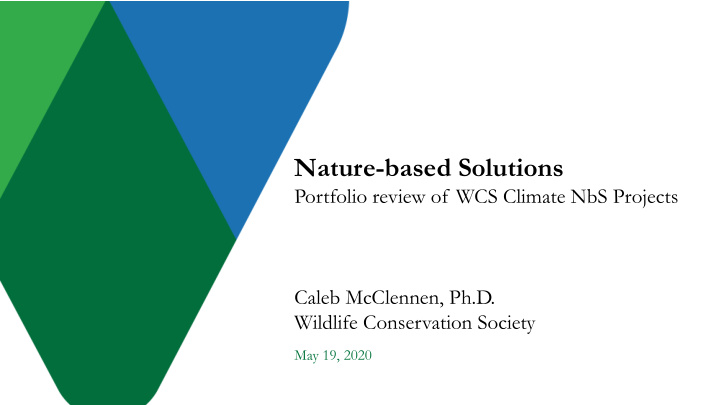



Nature-based Solutions Portfolio review of WCS Climate NbS Projects Caleb McClennen, Ph.D. Wildlife Conservation Society May 19, 2020
WCS Field Conservation in > 60 Countries 14 Global Priority Regions 400+ peer-reviewed publications per annum. Ongoing partnerships with more than 300 IPLCs > 50 Publicly Funded Climate NbS projects 2015-2019
WCS Climate NbS Strategy Protect Reduce Deforestation Intact Forests Frontiers Ecosystem Based Adaptation
WCS Analysis of 50 Publicly Funded Nature-based projects 2015-2019
Methods Reviewed portfolio of 600 publicly funded projects 2015-2020 to select subset of 50 with NbS climate focus. Utilized subset of the STAP/ U of Michigan analytical framework Categorized projects by: geography, partnership with IPLCs, policy objectives and NbS type.
NbS Climate Portfolio 2015-2019
Focal Ecosystems: Forests and Marine 32 projects, 60.4% Forest Coastal/Marine 16 projects, 30.2% Rural/Agricultural 3 projects, 5.6% Montane 6 projects, 11.3% Riparian 2 projects, 3.7% 0 5 10 15 20 25 30 35
NbS Focus: Protection, Adaption & Management 20 projects, 37% Protection Adaptation 16 projects, 31% Management 13 projects, 24% Infrastructure 0 projects, 0% Restoration 1 project, 2% 0 5 10 15 20 25
Key NbS Project Elements = 35 projects, 66% Research and Analysis Capacity Building/Training = 42 projects, 79.2% Policy Change = 26 projects, 49.1% 0 5 10 15 20 25 30 35 40 45
Partnerships 30 projects, 56.6% Local communities Local governments 17 projects, 32.1% Indigenous communities 10 projects, 18.9% 0 5 10 15 20 25 30 35
Case Study 1: Enhance Stakeholder Engagement for Uganda’s National REDD+ Programme in the Albertine Region
Case Study 2: Scaling up marine protected areas in Melanesia for biodiversity conservation, food security and livelihoods
WCS Climate Adaptation Fund (CAF) $19.6 million invested in 104 adaptation projects from 40 U.S. states and territories
CAF Criteria for success 1. Use of Information: Adaptive Management, Knowledge, M&E 2. Project Management: Achievement of Objectives, Engagement, Finances, Sustainability, Partnerships and Capacity 3. Social and Ecological Effects: Ecosystem Function, Social, Wildlife 4. Advancing the Field: Capacity Building, Innovation, Mainstreaming, Policy
Resistance – Resilience – Transformation Assisted migration outside spp current range Assisted migration w/in a population or spp current range; climate-informed forestry that directs future spp composition Create new climate-informed connectivity; living shorelines; climate- informed forestry without directing spp. composition Re-introduce ecosystem engineers (e.g., beavers); restore corridors to allow for species movements; restore with native species Protecting important ecosystems (creation, expansion of PAs in climate refugia) Preventing species transition by eliminating non-native species
CAF: From Resistance to Transformation
Discussion Topics 1. Mainstreaming Climate NbS in Policy still work in progress. 2. The portfolio addresses multiple societal challenges beyond climate, specifically food security and economic development. 3. Notable lack of Climate NbS projects linked to health. 4. Review demonstrates critical role of engaging IPLC for success. 5. More comprehensive review and post-project interrogation needed. 6. Many projects initially conservation focused. Development of best practices for NbS would help improve impact on societal benefits.
Questions
Recommend
More recommend